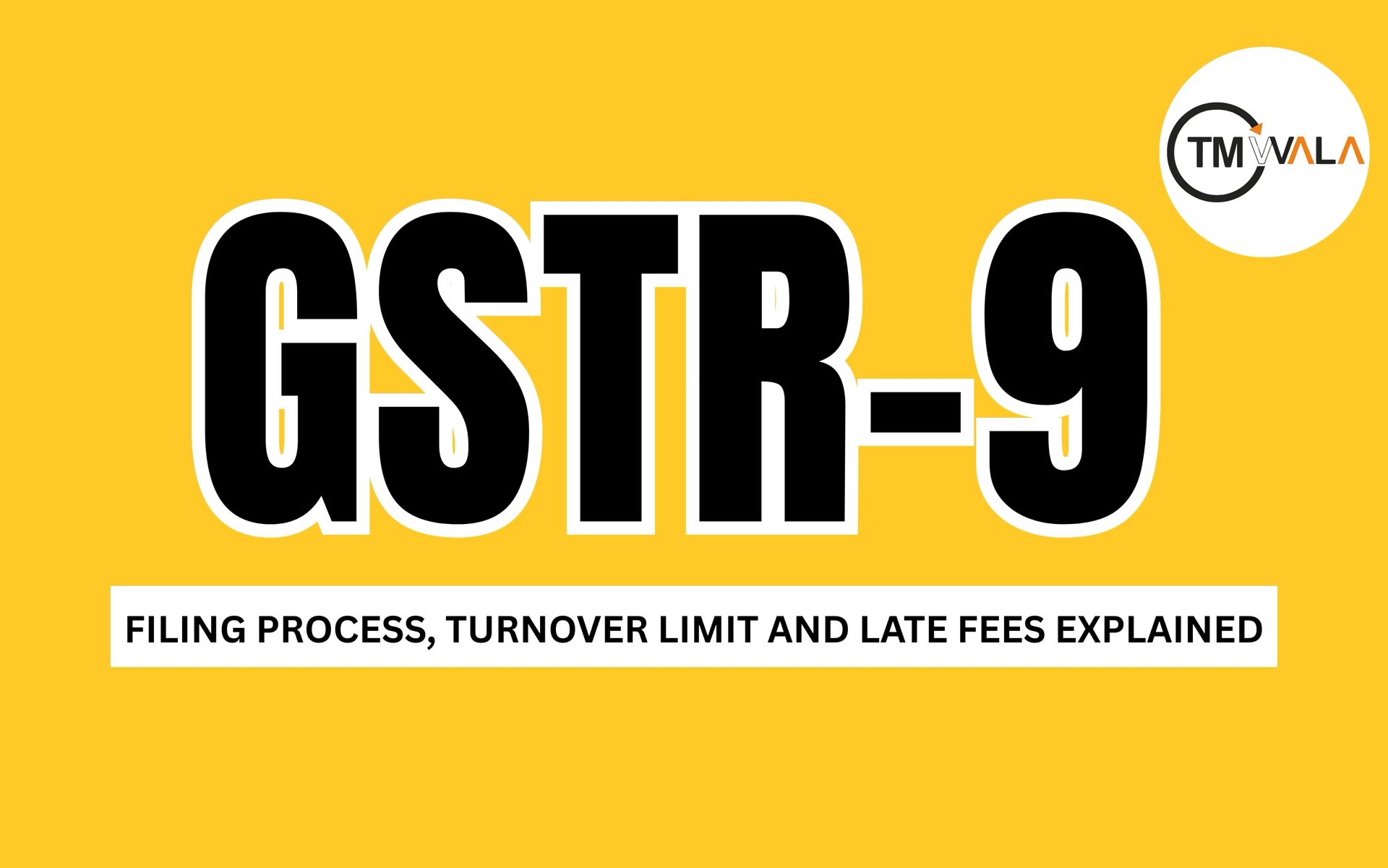
Introduction
Form GSTR-9 is the annual return under GST law that must be filed by registered taxpayers who operate as regular taxpayers, including SEZ units and SEZ developers. It consolidates the details of outward and inward supplies, input tax credit, tax paid, and other related activities for a financial year. This return acts as a reconciliation tool and helps the tax authorities assess compliance.
Understanding what is GSTR 9, who is required to file GSTR 9, what is the due date for GSTR 9, and how to file the GSTR 9 annual return is essential for timely and accurate compliance. The GSTR 9 turnover limit determines mandatory filing based on business size, while missing the deadline may attract penalties under the GSTR 9 late fees provisions. The late fee for GSTR 9 is calculated daily, with maximum limits specified by law.
This article provides a complete overview of the GSTR 9 filing process, including eligibility, due dates, turnover limits, step-by-step filing instructions, and penalty structures to help taxpayers file correctly and avoid non-compliance.
Form GSTR-9 is the annual return prescribed under the GST law that must be filed by registered taxpayers who operate as regular taxpayers, including Special Economic Zone (SEZ) units and SEZ developers. Form GSTR-9 is an annual return to be filed once for each financial year by the registered taxpayers who were regular taxpayers, including SEZ units and SEZ developers.
This comprehensive document requires taxpayers to furnish consolidated details of all their transactions, including purchases, sales, input tax credit claimed, refunds received, and demands created during the respective financial year. The annual return serves multiple purposes within the GST framework. It acts as a reconciliation tool between the data reported in monthly returns (GSTR-1 and GSTR-3B) and the actual business transactions conducted during the year. Additionally, it provides tax authorities with comprehensive information to assess the taxpayer’s compliance status and identify any discrepancies that may require further scrutiny.
The filing obligation for GSTR-9 extends to specific categories of registered taxpayers under the GST regime. Form GSTR-9 is to be filed by a person who is registered as a normal taxpayer, including SEZ unit or SEZ developer, and the taxpayers who have withdrawn from the composition scheme to normal taxpayer any time during the financial year.
Mandatory Filing Categories
The following categories of taxpayers are mandatorily required to file GSTR-9:
Exempted Categories
While the GST law mandates GSTR-9 filing for regular taxpayers, the government has provided relief to certain categories through notifications. Small taxpayers with aggregate turnover up to specified limits may be exempted from this requirement to reduce the compliance burden.
GSTR 9 Turnover Limit
The concept of the GSTR-9 turnover limit filing has evolved significantly since the implementation of GST. The government has established specific thresholds to balance compliance requirements with ease of doing business for smaller enterprises.
Current Turnover Thresholds for GSTR 9
The following table outlines the current turnover limits for GSTR-9 filing:
| Financial Year | Turnover Threshold | Filing Requirement | Status |
| 2019-20 | Above Rs. 2 crores | Mandatory | Optional for turnover up to Rs. 2 crores |
| 2020-21 | Above Rs. 2 crores | Mandatory | Optional for turnover up to Rs. 2 crores |
| 2021-22 onwards | Above Rs. 2 crores | Mandatory | Optional for turnover up to Rs. 2 crores |
Special Cases for Turnover Limits
What is the Due Date for GSTR 9?
The statutory due date for filing GSTR-9 is clearly defined under the GST regulations. The due date for filing Form GSTR-9 for a particular financial year is 31st December of the subsequent financial year or as extended by the Government through notification from time to time.
Due Date Schedule
The following table provides the due date schedule for the last five financial years:
| Financial Year | Original Due Date | Extended Due Date (if applicable) |
| 2020-21 | December 31, 2021 | Extended multiple times |
| 2021-22 | December 31, 2022 | Extended multiple times |
| 2022-23 | December 31, 2023 | Extended multiple times |
| 2023-24 | December 31, 2024 | Filed as per schedule |
| 2024-25 | December 31, 2025 | To be notified |
Extension Provisions
Yes, the date of filing of Form GSTR-9 can be extended by the Government through a notification. The government has historically extended due dates to provide taxpayers with additional time to ensure accurate compliance, particularly during the initial years of GST implementation and during exceptional circumstances such as the COVID-19 pandemic.
Step 1: Portal Access and Login Navigate to the official GST portal (www.gst.gov.in) and log in using valid credentials. Navigate to Services > Returns > Annual Return to file Form GSTR-9.
Step 2: Selection of Financial Year. Select the appropriate financial year for which the annual return is being filed.
Step 3: Auto-Population of Data The system automatically populates certain fields from previously filed monthly returns. Tables below in Form GSTR-9 have auto-populated data from already filed Form GSTR-1 and Form GSTR-3B of the relevant financial year:
Step 4: Manual Data Entry and Verification. Taxpayers must manually enter information in tables not auto-populated by the system:
Step 5: Data Reconciliation and Corrections. Compare auto-populated data with actual business records and make necessary corrections where permissible. Note that certain fields cannot be edited after auto-population.
Step 6: Computation of Liabilities After the COMPUTE LIABILITIES button is clicked, details provided in various tables are processed on the GST Portal at the back end, and Late fee liabilities, if any, are computed.
Step 7: Payment of Outstanding Dues. Clear any outstanding tax liabilities or late fees before proceeding with the filing. Additional liability not reported earlier can be declared and paid through Form GST DRC-03.
Step 8: Preview and Final Verification Review the return using the preview function available in both PDF and Excel formats. Verify all entries for accuracy and completeness.
Step 9: Filing and Digital Authentication Submit the return using Digital Signature Certificate (DSC) or Electronic Verification Code (EVC) after completing the declaration.
Alternative Filing Methods
Yes, Form GSTR-9 return can be filed through the offline tool. This option provides flexibility for taxpayers who prefer to prepare their returns offline before uploading to the portal.
The step-by-step GSTR-9 filing process, annual return, involves specific technical procedures that must be followed precisely:
Login and Navigation:
Data Preparation:
Form Completion:
Liability Computation:
Payment and Filing:
Late filing of GSTR-9 attracts specific penalties and fees as prescribed under the GST law. Understanding these provisions is essential for maintaining compliance and avoiding unnecessary financial burden.
Yes, there is a late fee for GSTR-9 beyond the due date. The late fee calculation follows a specific methodology:
| Component | Rate | Maximum Limit |
| CGST Late Fee | Rs. 100 per day | 0.25% of turnover in the state |
| SGST Late Fee | Rs. 100 per day | 0.25% of turnover in the state |
| Total Daily Late Fee | Rs. 200 per day | 0.5% of aggregate turnover |
Special Relief Measures for Late Fee for GSTR 9
The government has provided significant relief for pending GSTR-9 returns:
Penalty Implications Beyond Late Fees
No. You can’t file Form GSTR-9 without payment of the late fee for Form GSTR-9 if the same is filed after the due date. Beyond late fees, non-compliance with GSTR-9 filing requirements may attract additional penalties under Section 125 of the CGST Act, which can range up to Rs. 25,000 and may be imposed by both Central and State GST authorities.
Filing the annual GST return is a crucial compliance responsibility for all regular taxpayers under the GST regime. Understanding what is GSTR 9 and who is required to file GSTR 9 ensures that taxpayers meet their obligations without confusion. Awareness of the due date for GSTR 9 is equally important to avoid penalties and maintain a clean compliance record.
The GSTR 9 filing process involves data reconciliation, verification, and submission through the GST portal or offline tools. Knowing how to file the GSTR 9 annual return step-by-step helps taxpayers complete the process smoothly.
The GSTR 9 turnover limit determines whether filing is mandatory based on annual turnover, while timely action helps avoid the burden of GSTR 9 late fees. For those missing the deadline, the late fee for GSTR 9 can add up significantly and even attract further penalties if non-compliance continues.
Taxpayers are encouraged to review their records, reconcile their data, and file their annual return well before the deadline to ensure full compliance under GST law.
Bibliography
Get started instantly
"*" indicates required fields

TMWala
Your one stop shop for all your business registration and compliance needs.
"*" indicates required fields
Choose your Entity Type
Non-MSME/ Large Entitie
Individual/ MSME/ Sole Proprietorships

₹9,000.00 Original price was: ₹9,000.00.₹3,999.00Current price is: ₹3,999.00.
Trademark Application @ ₹3999* (Premium Discounted Plan for MSME/Individual/Sole Proprietorships) Comprehensive
Government Fees
₹4500/-

₹9,000.00 Original price was: ₹9,000.00.₹3,999.00Current price is: ₹3,999.00.
Trademark Application @ ₹3999* (Premium Discounted Plan for Non-MSMEs/Large Entities) Comprehensive
Government Fees
₹9000/-
Choose your Entity Type
Individual/ MSME/ Sole Proprietorships
Non-MSME/ Large Entities
₹3,500.00 Original price was: ₹3,500.00.₹1,999.00Current price is: ₹1,999.00.
Government Fees
₹4500/-
₹3,500.00 Original price was: ₹3,500.00.₹1,999.00Current price is: ₹1,999.00.
Government Fees
₹9000/-
Choose your Entity Type
Individual/ MSME/ Sole Proprietorships
Non-MSME/ Large Entities

₹1,500.00 Original price was: ₹1,500.00.₹999.00Current price is: ₹999.00.
Trademark Application @ ₹999* (Basic Discounted Plan for MSME/Individual/Sole Proprietorships) Best-Selling, Economical & Easy

₹1,500.00 Original price was: ₹1,500.00.₹999.00Current price is: ₹999.00.
Trademark Application @ ₹999* (Basic Discounted Plan for Non-MSMEs/Large Entities) Best-Selling, Economical, Quick and Easy